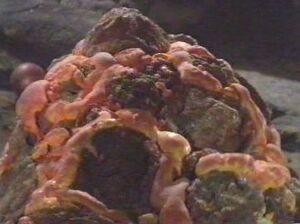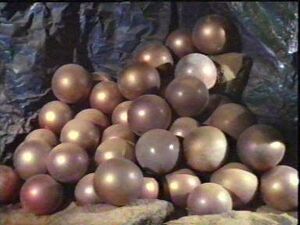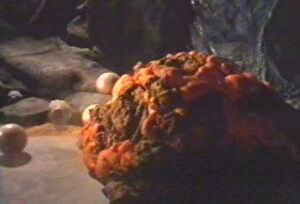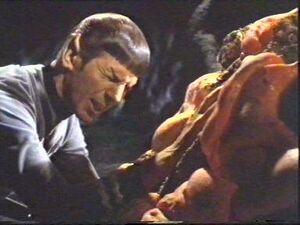The Horta Report: Difference between revisions
Herbalsheila (talk | contribs) |
(Reverting to last revision not containing links to www.startrekfreedom.com) |
||
| (12 intermediate revisions by 2 users not shown) | |||
| Line 2: | Line 2: | ||
== Horta Basics == | == Horta Basics == | ||
[[Image:horta2.jpg | [[Image:horta2.jpg|thumb|right|Horta]]The Horta (Hortensia acidophlangia) species are indigenous to Janus VI. They are one of a very few known silicon based life forms [[http://en.wikipedia.org/wiki/Alternative_biochemistry]] ever discovered. They were discovered by the human (Homo sapiens) mining colony on Janus when the miners inadvertantly broke into the Horta's hatchery. See [[http://en.wikipedia.org/wiki/The_Devil_in_the_Dark]] for more on how the Horta species was discovered and found to be peaceful and sentient. They consume rock, minerals, and metallic ores by liquifying it with a very strong highly corrosive acid exuded from their undersides and then swiftly ingesting the resulting mixture. The acid, upon exposure to air oxidizes harmlessly and within a few minutes is neutralized. In feeding, they create tunnels and other underground cave-like structures and are the greatest natural geologists and miners in the known universe. | ||
== Life as a Young Horta == | == Life as a Young Horta == | ||
[[Image:horta3.jpg | [[Image:horta3.jpg|thumb|left|Horta nodules]]Hortas are birthed out of [[silicon nodules]] or eggs. They hatch without any armor and are still soft and exude acid uncontrollably. They are born hungry and begin tunneling and feeding almost immediately and within a week or so their first protective armor shell has formed. They vary about 1/2 to 1 foot across in size and are round or ovoid when first hatched. Often their first meal is whatever is left of their silicon egg shell. As they grow their first armor shell, they gain control over their ability to exude acid to which they themselves are immune. | ||
Dancing or twirling is one behavior that has been observed in young Horta to express joy and playfulness. This behavior is most often exhibited after they have hardened their first shell of armor and have gained basic control over exuding acid. After their first few weeks of life most Horta are competitive to some degree and enjoy racing games through their caves and existing tunnels. | Dancing or twirling is one behavior that has been observed in young Horta to express joy and playfulness. This behavior is most often exhibited after they have hardened their first shell of armor and have gained basic control over exuding acid. After their first few weeks of life most Horta are competitive to some degree and enjoy racing games through their caves and existing tunnels. | ||
| Line 18: | Line 12: | ||
== Life as an Adult Horta == | == Life as an Adult Horta == | ||
[[Image:horta1.jpg | [[Image:horta1.jpg|thumb|right|An adult Horta]]A Horta's full size is about 5 to 7 feet long. They are about 3 feet wide and about 2 to 2 and 1/2 feet high and can vary widely in color depending on diet. They can weigh up to 500 pounds due to their heavy outside armor. At this time they have been clocked up to 5.5 miles per hour when full grown with their heavier well developed adult armor. A Horta looks like a large flattish grouping of lumpy molten rock. They have hair-like [[phalanges]] on their undersides which serve the dual purpose of sweeping up rock dust and other pebbles for ingestion and to control the acid and rock mixture as they feed. It is unknown at this time how long a Horta can live, but current estimates are at least 300 years. | ||
Each Horta has one limb or tentacle | Each Horta has one limb or tentacle that grows amongst its [[phalanges]], usually on or close to one end of their oblong bodies on the underside. It is prehensile and both allows them to grasp objects and to touch each other for purposes of relating and communication and is much like the tails on some of Earth's primates. An adult's appendage can grow up to three feet but it is considered among the Horta culture to be rude to drag their appendage on the ground after them. They consider it better manners to keep it coiled and tucked up neatly underneath their bodies and used when neccessary for specific tasks. | ||
== Horta's Senses == | |||
Hortas have sensory input in several ways. One is by detecting vibrations that others send out from talking, walking or running, heartbeat, breathing and general movement. Thus a Horta can detect rocks falling in an underground cave twenty feet below, someone running away on the other side of a hill out of human optical sight, a herd of animals stampeding two hundred miles away, or the muted roar of an underground river. This type of passive sonar is akin to the human ability to hear. | Hortas have sensory input in several ways. One is by detecting vibrations that others send out from talking, walking or running, heartbeat, breathing and general movement. Thus a Horta can detect rocks falling in an underground cave twenty feet below, someone running away on the other side of a hill out of human optical sight, a herd of animals stampeding two hundred miles away, or the muted roar of an underground river. This type of passive sonar is akin to the human ability to hear. | ||
On earth, sharks and many kinds of fish have special sensory organs that can sense electrical impulses. A Horta can see much the same way only much more refined. This gives them the ability to think very quickly and with a superfast brain a Horta can actually see the electrical impulses in living things from humanoids down to plants, not to mention all the electical impulses in a starship or starbase. This would mean that a Horta could see the impulses and be mentally quick enough to anticipate movements, giving it a slight look into [[Image:horta4.jpg|thumb|left| | On earth, sharks and many kinds of fish have special sensory organs that can sense electrical impulses. A Horta can see much the same way only much more refined. This gives them the ability to think very quickly and with a superfast brain a Horta can actually see the electrical impulses in living things from humanoids down to plants, not to mention all the electical impulses in a starship or starbase. This would mean that a Horta could see the impulses and be mentally quick enough to anticipate movements, giving it a slight look into [[Image:horta4.jpg|thumb|left|Horta mother mind-melding with Spock]]the 'future', and allowing it to dodge before anyone pulls the trigger of a phaser, or get out of the way of a thrown object. This electrical sensitvity is extended all over the body, meaning that when the pehensile phalange is raised up to a control pannel, the Horta would still be able to see through the sensory input from the appendage itself. A ship's walls or computer consoles would show up as strong fluxes of electrical energy where most creatures that are bio-chemically electrical in function show up as more fragile and dimmer shapes, but up close as sparkling shaped spiderey like webs. This type of electrical impulse detection is akin to the human ability to see, but in the Hortas it also allows them the ability to communicate and speak to each other by touch via electrical impulse exchange. | ||
Another way that Hortas have sensory input is by taste. Most Hortas can detect any type of rock, mineral, or metallic ore by taste, just as humans can tell which food they are eating by taste if blinfolded. This makes Hortas living soil analysis machines. A Horta might then be helpful in detecting extraneous chemicals which might poison a carbon based life form, but not necessarily a silicon based life form. In the exploration of space, however, it might be wise to be cautious before allowing a curious Horta to ingest unknown substances as what might poison a Horta in deep space is still unknown at this time. | |||
== Hortan Tradition and Culture == | == Hortan Tradition and Culture == | ||
| Line 46: | Line 30: | ||
Not much is known about mating selection or mating practices, although it has been observed that a favorite line of male Hortas translates as “From under what rock did you crawl out?" | Not much is known about mating selection or mating practices, although it has been observed that a favorite line of male Hortas translates as “From under what rock did you crawl out?" | ||
== Credits == | |||
written by [[herbalsheila]] with lots of input from conversations with [[User:dragonman-clone |dragonman-clone]] on the [[Star Trek: Freedom]] [[http//:www.StarTrekFreedom.com]] forum boards. | |||
[[Naraht the Horta]] | |||
Became good friends with a [[Gorn]] that joined Starfleet in the Academy. | |||
About silicon based life forms: http://en.wikipedia.org/wiki/Alternative_biochemistry | |||
How the Horta Species was discovered: http://en.wikipedia.org/wiki/The_Devil_in_the_Dark | |||
[[Category:Database]] [[Category:Science]] [[Category:Species | [[Category:Database]] [[Category:Science]] [[Category:Species]] | ||
Latest revision as of 09:30, 22 November 2012
Put together by herbalsheila and dragonman-clone.
Horta Basics[edit]
The Horta (Hortensia acidophlangia) species are indigenous to Janus VI. They are one of a very few known silicon based life forms [[1]] ever discovered. They were discovered by the human (Homo sapiens) mining colony on Janus when the miners inadvertantly broke into the Horta's hatchery. See [[2]] for more on how the Horta species was discovered and found to be peaceful and sentient. They consume rock, minerals, and metallic ores by liquifying it with a very strong highly corrosive acid exuded from their undersides and then swiftly ingesting the resulting mixture. The acid, upon exposure to air oxidizes harmlessly and within a few minutes is neutralized. In feeding, they create tunnels and other underground cave-like structures and are the greatest natural geologists and miners in the known universe.
Life as a Young Horta[edit]
Hortas are birthed out of silicon nodules or eggs. They hatch without any armor and are still soft and exude acid uncontrollably. They are born hungry and begin tunneling and feeding almost immediately and within a week or so their first protective armor shell has formed. They vary about 1/2 to 1 foot across in size and are round or ovoid when first hatched. Often their first meal is whatever is left of their silicon egg shell. As they grow their first armor shell, they gain control over their ability to exude acid to which they themselves are immune.
Dancing or twirling is one behavior that has been observed in young Horta to express joy and playfulness. This behavior is most often exhibited after they have hardened their first shell of armor and have gained basic control over exuding acid. After their first few weeks of life most Horta are competitive to some degree and enjoy racing games through their caves and existing tunnels.
They are faster when smaller and lighter. As they age and become larger and heavier their armor grows thicker, and they gradually lose the ablity to be as quick. Young Hortas have been clocked at moving up to 7 miles per hour. It is presently unknown what might be its top speed. They can move quickly and quietly when needful even as adults.
Life as an Adult Horta[edit]
A Horta's full size is about 5 to 7 feet long. They are about 3 feet wide and about 2 to 2 and 1/2 feet high and can vary widely in color depending on diet. They can weigh up to 500 pounds due to their heavy outside armor. At this time they have been clocked up to 5.5 miles per hour when full grown with their heavier well developed adult armor. A Horta looks like a large flattish grouping of lumpy molten rock. They have hair-like phalanges on their undersides which serve the dual purpose of sweeping up rock dust and other pebbles for ingestion and to control the acid and rock mixture as they feed. It is unknown at this time how long a Horta can live, but current estimates are at least 300 years.
Each Horta has one limb or tentacle that grows amongst its phalanges, usually on or close to one end of their oblong bodies on the underside. It is prehensile and both allows them to grasp objects and to touch each other for purposes of relating and communication and is much like the tails on some of Earth's primates. An adult's appendage can grow up to three feet but it is considered among the Horta culture to be rude to drag their appendage on the ground after them. They consider it better manners to keep it coiled and tucked up neatly underneath their bodies and used when neccessary for specific tasks.
Horta's Senses[edit]
Hortas have sensory input in several ways. One is by detecting vibrations that others send out from talking, walking or running, heartbeat, breathing and general movement. Thus a Horta can detect rocks falling in an underground cave twenty feet below, someone running away on the other side of a hill out of human optical sight, a herd of animals stampeding two hundred miles away, or the muted roar of an underground river. This type of passive sonar is akin to the human ability to hear.
On earth, sharks and many kinds of fish have special sensory organs that can sense electrical impulses. A Horta can see much the same way only much more refined. This gives them the ability to think very quickly and with a superfast brain a Horta can actually see the electrical impulses in living things from humanoids down to plants, not to mention all the electical impulses in a starship or starbase. This would mean that a Horta could see the impulses and be mentally quick enough to anticipate movements, giving it a slight look into
the 'future', and allowing it to dodge before anyone pulls the trigger of a phaser, or get out of the way of a thrown object. This electrical sensitvity is extended all over the body, meaning that when the pehensile phalange is raised up to a control pannel, the Horta would still be able to see through the sensory input from the appendage itself. A ship's walls or computer consoles would show up as strong fluxes of electrical energy where most creatures that are bio-chemically electrical in function show up as more fragile and dimmer shapes, but up close as sparkling shaped spiderey like webs. This type of electrical impulse detection is akin to the human ability to see, but in the Hortas it also allows them the ability to communicate and speak to each other by touch via electrical impulse exchange.
Another way that Hortas have sensory input is by taste. Most Hortas can detect any type of rock, mineral, or metallic ore by taste, just as humans can tell which food they are eating by taste if blinfolded. This makes Hortas living soil analysis machines. A Horta might then be helpful in detecting extraneous chemicals which might poison a carbon based life form, but not necessarily a silicon based life form. In the exploration of space, however, it might be wise to be cautious before allowing a curious Horta to ingest unknown substances as what might poison a Horta in deep space is still unknown at this time.
Hortan Tradition and Culture[edit]
Hortas think of most humanoids as tall graceful stalks, and often in their culture refer to them as such. They live peacefully in groups and get along well with little violence, although the children can often act up when playing like many young of humanoid species.
The Hortas have a rich and varied musical and lingusitic tradition, much of which is based in a rock, mineral and metal context. Rythm, tone and word images of long duration are passed on from generation to generation, similiar to the stories of ancient Irish, Scottish and Welsh cultures millenia ago on Earth as well as highly developed philosphical and religious beliefs and practices that have not been yet recorded at this time.
Not much is known about mating selection or mating practices, although it has been observed that a favorite line of male Hortas translates as “From under what rock did you crawl out?"
Credits[edit]
written by herbalsheila with lots of input from conversations with dragonman-clone on the Star Trek: Freedom http//:www.StarTrekFreedom.com forum boards.
Became good friends with a Gorn that joined Starfleet in the Academy.
About silicon based life forms: http://en.wikipedia.org/wiki/Alternative_biochemistry
How the Horta Species was discovered: http://en.wikipedia.org/wiki/The_Devil_in_the_Dark



